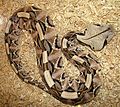| Image | Species [1] | Taxon author [1] | Subsp.* [4] | Common name | Geographic range [1] |
|---|
| B. albanica | Hewitt, 1937 | 0 | Albany adder | Republic of South Africa, Eastern Cape Province from Port Elizabeth to near Committees. |
 | B. arietans T | (Merrem, 1820) | 1 | Puff adder | Most of sub-Saharan Africa south to the Cape of Good Hope, including southern Morocco, Mauritania, Senegal, Mali, southern Algeria, Guinea, Sierra Leone, Ivory Coast, Ghana, Togo, Benin, Niger, Nigeria, Chad, Sudan, Cameroon, Central African Republic, northern, eastern and southern Democratic Republic of the Congo, Uganda, Kenya, Somalia, Rwanda, Burundi, Tanzania, Angola, Zambia, Malawi, Mozambique, Zimbabwe, Botswana, Namibia, South Africa, also occurs on the Arabian peninsula, where it is found in southwestern Saudi Arabia and Yemen |
 | B. armata | (A. Smith, 1826) | 0 | Southern adder | Republic of South Africa, Southwestern Western Cape, from West Coast National Park to De Hoop Nature Reserve |
 | B. atropos | (Linnaeus, 1758) | 0 | Berg adder | Isolated populations in the mountainous areas of southern Africa: the Inyanga Highlands and Chimanimani Mountains of eastern Zimbabwe and nearby Mozambique, in South Africa along the Drakensberg Escarpments in the provinces of Transvaal, western Natal, Lesotho and eastern Free State, and in the southern coastal mountains of western and eastern Cape Province |
 | B. caudalis | (A. Smith, 1839) | 0 | Horned adder | The arid region of southwest Africa: southwest Angola, Namibia, across the Kalahari Desert of southern Botswana, into northern Transvaal and southwestern Zimbabwe, in South Africa from the northern Cape Province south to the Great Karoo |
 | B. cornuta | (Daudin, 1803) | 0 | Many-horned adder | The coastal region of southwest Namibia through west and southwest Cape Province in South Africa, with a few isolated populations in eastern Cape Province |
 | B. gabonica | (A.M.C. Duméril, Bibron & A.H.A. Duméril, 1854) | 0 | Gaboon viper | Guinea, Ghana, Togo, Nigeria, Cameroon, DR Congo, Central African Republic, southern Sudan, Uganda, Kenya, eastern Tanzania, Zambia, Malawi, eastern Zimbabwe, Mozambique, northeast KwaZulu-Natal Province in South Africa |
| B. harenna | Gower, Wade, Spawls, Böhme, Buechley, Sykes, & Colston, 2016 | 0 | Bale Mountains adder | Ethiopia |
| B. heraldica | (Bocage, 1889) | 0 | Angolan adder | The high plateau of central Angola |
 | B. inornata | (A. Smith, 1838) | 0 | Plain mountain adder | Isolated population on the Sneeuberge, eastern Cape Province, South Africa |
 | B. nasicornis | (Shaw, 1792) | 0 | Rhinoceros viper | From Guinea to Ghana in West Africa, and in Central Africa in the Central African Republic, southern Sudan, Cameroon, Gabon, Congo, DR Congo, Angola, Rwanda, Uganda and western Kenya |
 | B. parviocula | Böhme, 1977 | 0 | Ethiopian mountain adder | Known from only five localities in the highlands to southwest Ethiopia, at altitudes of 1700–2800 m. [11] |
 | B. peringueyi | (Boulenger, 1888) | 0 | Peringuey's desert adder | The Namib Desert from southern Angola to Lüderitz, Namibia |
 | B. rhinoceros | (Schlegel, 1855) | 0 | West African Gaboon viper | Guinea, Guinea-Bissau, Liberia, Sierra Leone, Ivory Coast, Ghana, Togo |
 | B. rubida | Branch, 1997 | 0 | Red adder | Several isolated populations in the northern Cape Fold Mountains and inland escarpment in Western Cape Province, South Africa |
 | B. schneideri | (Boettger, 1886) | 0 | Namaqua dwarf adder | White coastal sand dunes from Namibia, near Lüderitz, south to Hondeklip Bay, Little Namaqualand, South Africa |
 | B. worthingtoni | Parker, 1932 | 0 | Kenya horned viper | Restricted to Kenya's high central Rift Valley at altitudes over 1500 m |
 | B. xeropaga | Haacke, 1975 | 0 | Desert mountain adder | Northwestern Cape Province in South Africa and the arid mountains of the lower Orange River basin, north into southern Namibia and Great Namaqualand as far as Aus |
|
















